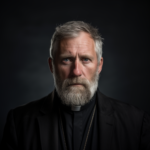
St. Ingrid of Sweden
St. Ingrid of Sweden
St. Ingrid of Sweden, also known as Princess Ingrid Birgersdotter, was a remarkable figure who lived during the 13th century, passing away in 1282. Her life and legacy left an indelible mark on Swedish religious history, particularly within the Dominican tradition. This blog post explores her life, spirituality, and historical context in detail.
Early Life and Historical Context
Ingrid was born in Sweden to noble parents in the early 13th century. Her family belonged to the Elofssönernas ätt, part of the Swedish nobility. Her father was named Elof, and the family lived in Skänninge, a town in Östergötland, Sweden.
Ingrid’s life unfolded against the backdrop of a rapidly changing Europe. The 13th century saw significant developments in religious life, intellectual pursuits, and social structures. Some notable events and trends of her era included:
- The Crusades: The latter part of the Crusades occurred during Ingrid’s lifetime, with the Seventh Crusade (1248-1254) and the Eighth Crusade (1270) taking place.
- The Rise of Gothic Architecture: This period saw the construction of many great Gothic cathedrals across Europe.
- The Mongol Empire: The expansion of the Mongol Empire under Genghis Khan and his successors was reshaping much of Eurasia during this time.
- The Founding of European Universities: Many of Europe’s oldest universities were established in the 13th century, including the University of Cambridge (1209) and the University of Salamanca (1218).
Marriage and Widowhood
As was customary for noblewomen in 13th-century Sweden, Ingrid married young. However, her husband died shortly after their marriage, leaving Ingrid a young widow. This experience of widowhood would profoundly shape her spiritual journey and future life choices.
The Social Context of Widowhood in Medieval Sweden
In 13th-century Scandinavian society, widowhood presented both challenges and opportunities for women:
- Legal Status: Swedish law granted widows significant legal rights. The Older Västgötalagen (West Geatish Law), one of the oldest Swedish provincial laws, stipulated that widows had the right to manage their own property and affairs.
- Social Expectations: Widows, especially those from noble families like Ingrid, were often expected to remarry to maintain familial alliances. Choosing a religious life was a significant departure from societal norms.
- Economic Considerations: Widows who did not remarry or enter religious life could face economic hardship, despite legal protections.
Ingrid’s Response to Widowhood
Ingrid’s response to her husband’s death was shaped by both her personal faith and the religious climate of her time:
- Grief and Contemplation: While we don’t have personal accounts, it’s likely that Ingrid entered a period of intense grief and contemplation, aligning with medieval Christian practices of mourning.
- Rejection of Remarriage: By choosing not to remarry, Ingrid rejected the conventional path for widowed noblewomen.
- Pilgrimage: Ingrid embarked on pilgrimages to the Holy Land, Rome, and Santiago de Compostela. These journeys served as acts of penance and devotion, a means of seeking divine guidance, and a way to physically distance herself from her former life.
- Almsgiving: Ingrid began to give away her wealth and worldly possessions, a radical act of charity reminiscent of other saintly widows like St. Elizabeth of Hungary.
Spiritual Journey and Dominican Life
During this tumultuous period, Ingrid’s relationship with her spiritual director, the Dominican friar Peter of Dacia, was crucial. Peter, known for his mystical writings and his association with the German mystic Christina of Stommeln, likely introduced Ingrid to Dominican spirituality.
Ingrid’s transition from widow to religious was not immediate. Historical records suggest a period of discernment that lasted several years. Eventually, she felt called to join the Dominican Order, a significant decision given that the Order of Preachers was still relatively new, having been founded by St. Dominic in 1216.
Establishing Skänninge Abbey
Under Peter of Dacia’s guidance, Ingrid, her sister, and other pious women formed an informal community of religious women. Eventually, Ingrid sought formal recognition for her convent, St. Martin’s, also known as Skänninge Abbey. She received this recognition one year before her death in 1282.
The establishment of this convent was a significant achievement. It was the first Dominican convent for women in Sweden, paving the way for women to participate in the intellectual and spiritual life of the Order. Ingrid likely faced numerous challenges in this endeavor, including securing funding, obtaining ecclesiastical approval, and adapting the Dominican rule for a female community.
Ingrid’s Dominican Spirituality
As a Dominican, Ingrid’s spirituality would have been characterized by several key elements:
- Contemplation and Action: The Dominican charism emphasizes a balance between contemplative prayer and active ministry.
- Intellectual Pursuit: Dominicans are known for their commitment to study. Ingrid would have dedicated herself to learning about theology, scripture, and the writings of the Church Fathers.
- Preaching and Teaching: While women in the 13th century were not permitted to preach publicly, Ingrid likely shared her knowledge and faith within her community and with those who sought her counsel.
- Communal Life: The Dominican tradition places great importance on community life, reflected in Ingrid’s establishment of Skänninge Abbey.
- Marian Devotion: The Dominican Order has a strong tradition of devotion to the Virgin Mary, which likely played a significant role in Ingrid’s spiritual life.
While we don’t have extensive writings from Ingrid herself, we can infer other aspects of her spirituality based on Dominican traditions and the practices of other female mystics of her time:
- Eucharistic Devotion: Like many medieval mystics, Ingrid likely had a deep devotion to the Eucharist.
- Asceticism: Her giving away of worldly possessions suggests that Ingrid practiced a form of radical poverty.
- Mysticism: Given the trends in female spirituality during this period, Ingrid may have experienced mystical visions or ecstasies, though we lack direct evidence of this.
- Service to Others: The Dominican emphasis on works of mercy suggests that Ingrid’s spirituality would have had a strong practical component.
Contemporary Saints and Influences
Ingrid’s lifetime coincided with several other notable saints who shaped the spirituality of the 13th century:
- St. Dominic (1170-1221): Founder of the Dominican Order.
- St. Francis of Assisi (1181/1182-1226): Known for his devotion to poverty and nature.
- St. Clare of Assisi (1194-1253): Founder of the Poor Clares.
- St. Elizabeth of Hungary (1207-1231): A princess who dedicated her life to serving the poor.
- St. Thomas Aquinas (1225-1274): A Dominican friar and influential theologian.
These contemporary figures, particularly within the Dominican tradition, likely influenced Ingrid’s spiritual formation and her vision for religious life in Sweden.
Legacy and Veneration
After Ingrid’s death in 1282, many people began to venerate her remains and remember her devout life. Reports of miracles occurring at her tomb drew pilgrims from across Sweden seeking her intercession.
The Swedish bishops initiated an inquisition, the first step towards potential canonization. Ingrid’s cause for canonization was presented to the Council of Constance. In 1499, Pope Alexander VI permitted the translation of her remains, and a Mass and office in her honor were composed.
However, the Swedish Reformation disrupted the process of her formal canonization. While it’s believed that her relics were destroyed along with her abbey during this period, Ingrid was never officially canonized, nor was her cause for canonization reopened.
Despite the lack of formal canonization, many Catholics, particularly in Sweden, continued to venerate Ingrid. Her feast day is observed on September 2nd in some local calendars. She became known as the patron saint of widows, with her life story inspiring those navigating the challenges of losing a spouse and those drawn to religious life.
Historical Significance and Continuing Relevance
Ingrid’s life and work had a lasting impact on Swedish religious life. She can be seen as a precursor to the more famous St. Bridget of Sweden (1303-1373), who would also establish a religious order. Like St. Catherine of Siena (1347-1380), another Dominican tertiary, Ingrid combined a life of intense prayer with active engagement in her community.
Ingrid’s journey from noblewoman to widow to religious founder provides a powerful example of female agency within the constraints of medieval society. Her story offers a model for balancing contemplation with active service and showcases women’s leadership in religious life.
The veneration of Ingrid, despite her lack of formal canonization, speaks to the deep impression she made on local spirituality. Her life continues to offer inspiration, particularly to those seeking to balance contemplative and active lives, and to women called to leadership in religious contexts.
In conclusion, St. Ingrid of Sweden stands as a remarkable figure in 13th-century religious history. Her response to personal tragedy, her embrace of Dominican spirituality, and her pioneering work in establishing Sweden’s first Dominican convent for women make her a noteworthy subject of study and veneration. Her legacy continues to resonate with those exploring the intersection of personal faith, communal religious life, and social engagement.
5 Interesting Facts About St. Ingrid of Sweden
- Ingrid was the first Swedish woman to adopt the Dominican habit.
- Ingrid founded the first Dominican convent in Sweden.
- Ingrid made pilgrimages to the Holy Land and Rome.
- Legend has it that Ingrid’s skull was stolen during the Reformation.
and later mistakenly displayed as the skull of Bridget of Sweden. - Ingrid was distantly related by marriage to St. Bridge of Sweden.
Prayer to St. Ingrid of Sweden
Lord God, you showered heavenly gifts on Blessed Ingrid the Virgin. Help us to imitate her virtues during our earthly lives and enjoy eternal happiness with her in heaven. Amen.
Contributed by [Good Books for Catholic Kids].ul



